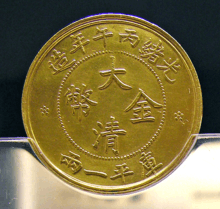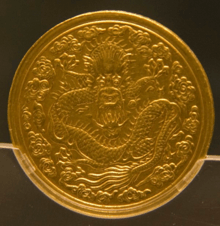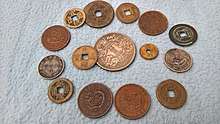Da-Qing Jinbi
The Da-Qing Jinbi (Traditional Chinese: 大清金幣) was the name of a unissued series of gold coins produced under the reign of the Guangxu Emperor. These coins were produced in the scenario that the government of the Manchu Qing dynasty would adopt the gold standard, as was common in most of the world at the time.
| Value | 1 Kuping tael |
|---|---|
| Mass | 37.5[1] g |
| Diameter | 39.5[1] mm |
| Composition | Gold |
| Years of minting | 1906–1907 (trial issues) |
| Circulation | No |
| Obverse | |
 | |
| Design | 光緒(丙午/丁未)年造 - 大清金幣 - 庫平一兩 |
| Reverse | |
 | |
| Design | A large dragon chasing a wish-granting pearl surrounded by auspicious clouds. |
During this the Qing dynasty era, the Chinese coinage system was based on a bimetallic system of copper and silver and these proposed coins would have also introduced gold coinage to China. However, only a small number of trial coins were produced in the years 1906 and 1907, despite the production these pattern coins the Da-Qing Jinbi did not ever see any circulation.
History
The Qing dynasty used a bimetallic currency system based on silver sycees and cast copper-alloy cash coins and during the 19th century modern machine-struck coinage from the Western world inspired the local production of milled coinages by provincial governments.[2][3] The first of these being provincial issues of the Guangxu Yuanbao (光緒元寶) which would later inspire the government of the Qing dynasty to standardise its currency nationwide due to the different weights and standards being used across China.[3]
During the later years of the Manchu Qing dynasty, the coinage system was scattered with central government-made coins, local coins and some foreign currencies circulating together in the private sector of China, resulting in a great deal of currency confusion, this has made both fiscal and financial management in China quite difficult. In an attempt to bring order to this chaos some people such as Chen Zhi started advocating for China to place its currency on the gold standard.[4] The reformer Liang Qichao campaigned for the government of the Qing dynasty to emulate the Western world and Japan by embracing the gold standard, unify refractory the currencies of China, and issue government-backed banknotes with a ⅓ metallic reserve.[5]
In the year Guangxu 29 (1903) the Ministry of Revenue in Beijing had authorised a small number of gold 1 Kuping tael Guangxu Yuanbao pattern coins with the English inscription "29TH YEAR OF KUANG HSÜ - HU POO", the dies for these coins were probably produced at the Japan Mint in Osaka, Japan.[6] In the year Guangxu 30 (1904) the Ministry of Revenue created a concrete implementation for the manufacture of gold coins,[7] while in Guangxu 31 (1905) the government of the Qing dynasty reformed the currency system to allow for gold coins, these would be cast by the Tianjin General Mint operated by the Ministry of Revenue with the inscription Da-Qing Jinbi (大清金幣),[8] These coins bore a similar inscription to the copper-alloy Da-Qing Tongbi (大清銅幣)[9][10] and the silver Da-Qing Yinbi (大清銀幣), which were both introduced to standardise the national coinages in their respective metals.[11][12]
Only a small number of trial coins with this inscription were ever cast that were not meant for general circulation as the gold reserves of the Qing dynasty proved insufficient. These coins weighed 1 Kuping Tael and were cast in the years Guangxu 32 (1906) and Guangxu 33 (1907) and featured a design of a Chinese dragon on one side and the inscription on the other with the year of casting shown in Chinese cyclical years.[8][13]
Because of the scarce production of these coins, Da-Qing Jinbi coins have been sold at auctions at high prices, during the 2010s a 1907 Da-Qing Jinbi was estimated to be worth between $80,000 and $100,000.[14] In 2006 a Da-Qing Jinbi coin was sold for RMB 2,090,000, in 2007 a 1907 Da-Qing Jinbi was sold for RMB 1,904,000 and another for RMB 1,064,000, in the year 2008 a 1906 Da-Qing Jinbi coin was sold for RMB 1,792,000, in 2013 a 1906 Da-Qing Jinbi coin was sold for RMB 1,150,000, and in 2014 a 1906 Da-Qing Jinbi was sold for RMB 897,000 at an auction in Beijing.[15][16]
Design
The obverse of the Da-Qing Jinbi coins featured the Traditional Chinese characters "大清金幣" which could be translated as "Gold currency of the Great Qing" in its centre, on the top of the coin was the date of manufacture using both the Chinese calendar date and the reign era of the Guangxu Emperor, 1906 coins had the text "造年午丙緒光" written from right to left, while 1907 coins featured the text "造年未丁緒光".[1] At the bottom of the coin was the text "兩一平庫" written from right to left indicating that the weight of the coin was 1 Kuping Tael (or 37.5 grams) of gold.[1] The reverse of these coins depicted a large Chinese dragon chasing the wish-granting pearl surrounded by auspicious clouds.[1]
| Variants of the Da-Qing Jinbi coins | |||
|---|---|---|---|
| Year (Chinese calendar) | Year (Gregorian calendar) | Year (Chinese era name) | Image |
| 光緒丙午年造 | 1906 | Guangxu 32 |  |
| 光緒丁未年造 | 1907 | Guangxu 33 |  |
References
- Numista (31 December 2019). "1 Liang - Guangxu (Pattern strike)". Numista. Retrieved 31 December 2019.
- Niv Horesh (2019). The Monetary System of China under the Qing Dynasty. Springer Link. pp. 1–22. doi:10.1007/978-981-10-0622-7_54-1. ISBN 978-981-10-0622-7.
- "Chinese coins – 中國錢幣 - Qing (Ch'ing) Dynasty (1644-1911)". Gary Ashkenazy / גארי אשכנזי (Primaltrek – a journey through Chinese culture). 16 November 2016. Retrieved 31 December 2019.
- Peng Xinwei (彭信威). 中國貨幣史. 1958-11. Page = 551 (in Mandarin Chinese).
- Hou Houji (侯厚吉), Wu Qijing (吴其敬) (1982) Zhongguo jindai jingji sixiang shigao (中國近代經濟思想史稿). Heilongjiang renminchubanshe, Harbin, vol. 3, pp. 322–339. (in Mandarin Chinese).
- Numista (1 January 2020). "1 Liang - Guangxu (Gold pattern)". Numista. Retrieved 1 January 2020.
- 平景賢; 王金谷. 中國錢幣珍品系列紀念章介紹 (一). 中國錢幣. 1991, (2): 79. (in Mandarin Chinese).
- "光绪丙午年造大清金币库平壹两一枚" (in Chinese). 北京保利国际拍卖有限公司. Archived from the original on 2018-02-04. Retrieved 2018-02-03.
- 广州轩宇艺术 (16 May 2019). "轩宇艺术:石先生出手一枚罕见户部造鄂字版大清铜币" (in Chinese). 中经在线网 (Zhongjin News). Retrieved 26 December 2019.
- 博华文化传媒 (19 December 2019). "广州博华文化传媒有限公司:张先生出手一组两枚价值不菲的户部造大清铜币" (in Chinese). 中经在线网 (Zhongjin News). Retrieved 26 December 2019.
- 每日頭條 - "原文網址:https://71a.xyz/wZVlD" (14 August 2016). "光緒元寶和大清銅幣到底值多少錢,收藏價值如何?" (in Chinese). KKNews. Retrieved 1 January 2020.
- 每日頭條 (22 July 2016). "宣統三年大清銀幣收藏投資價值參考分析" (in Chinese). KKNews. Retrieved 1 January 2020.
- "光绪丙午年造大清金币库平一两金质样币". 西泠印社 (in Chinese). Archived from the original on 2018-02-05. Retrieved 2018-02-05.
- paulfrasercollectibles (2015). "Chinese 1907 Guangxu coin could bring $100,000 to Baldwin's". Just Collecting. Retrieved 1 January 2020.
- 每日頭條 (8 October 2017). "大清金幣,存世極少,價值不菲" (in Chinese). KKNews. Retrieved 1 January 2020.
- 每日頭條 (12 November 2017). "大清金幣 欣賞" (in Chinese). KKNews. Retrieved 1 January 2020.
| Wikimedia Commons has media related to Dà Qīng Jīn Bì. |

_-_%E9%99%B3%E5%AE%97%E5%B6%BD.jpg)